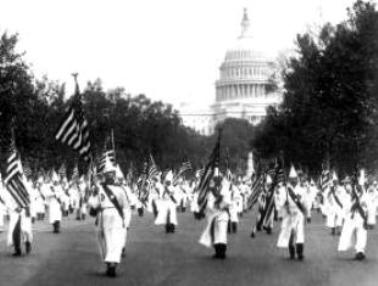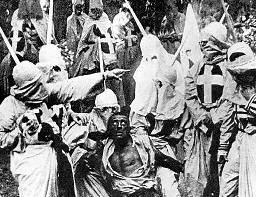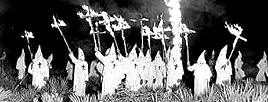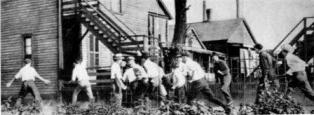|

1920's KKK: Ku Klux Klan marching down
Pennsylvania Avenue, Washington
|
1920's KKK Facts: Fast Fact Sheet
Fast, facts and Frequently Asked Questions (FAQ's)
about the 1920's KKK
(Ku Klux Klan in the 1920s).
What explains the rebirth of the Ku Klux
Klan in the 1920s? The rebirth, rise and
resurgence of the 1920's KKK was due to the
massive rise in immigration, the movement of
African Americans from the south to the
northern cities, race riots, strikes,
problems caused by industrialization and
Urbanization, the anti-immigration and
anti-radical hysteria of the Red Scare and a
series of terrorist attacks in America.
What groups were targeted by the Ku Klux
Klan in the 1920s?
The groups targeted by the 1920's KKK
included the 'New Immigrants', African
Americans, Mexicans, Jews, Catholics, Asians
and any groups who represented "un-American"
values or beliefs, such as organized labor.
Who was the leader of the 1920's KKK?
The leader of the 1920's KKK was William J.
Simmons, a former Methodist preacher, who
founded the new Ku Klux Klan in 1915 in
Atlanta, Georgia.
1920's KKK
Facts for kids
The following fact
sheet contains interesting facts and information on 1920's KKK
(Ku Klux Klan in the 1920s)
Facts
about the 1920's KKK (Ku Klux Klan in the 1920s)
1920's KKK Fact 1:
The resurgence of the new Ku Klux Klan was
led by William J. Simmons (May 6, 1880 – May 18, 1945),
a former Methodist preacher from Atlanta, Georgia, in
1915.
1920's KKK Fact
2:
The second era of the KKK began when fifteen
robed and hooded "charter members" of the new
organization, met at Stone Mountain November 25, 1915 to
create a new iteration of the Ku Klux Klan.
1920's KKK Fact 3:
William J. Simmons was inspired to reorganize the
second Ku Klux Klan after seeing the 1915 silent movie the "Birth of
a Nation".
The three hour "Birth of a Nation" was directed by D. W.
Griffith and based on the novel and play 'The Clansman' by Thomas
Dixon, Jr. and glorified the original Klan and its
'gallant and heroic'
Knights.

1920's KKK Fact 4:
The goal of the new Ku Klux Klan was to preserve
the white, Protestant civilization and the re-establishment of white
supremacy. The second era of the KKK promoted the ideology of
'Americanism' encompassing the notions of patriotism, loyalty,
allegiance to the USA and the promotion of its culture, traditions
and customs.
1920's KKK Fact 5:
The resurgence of the Ku Klux
Klan organization adopted a burning cross as its symbol.
The concept of cross
burning was introduced in the 'The Clansman' by Thomas Dixon, Jr.
The Members of the KKK wore the insignia, robes and hoods associated
with the Klan and participated in rituals and initiation ceremonies
featuring altars draped with the American flag.

1920's KKK Fact 6:
The rebirth of the second Ku Klux
Klan in the 1920s was well organized. The second KKK
held rallies, picnics, parades and marches all around
the United States.
1920's KKK Fact 7:
Targets: The groups targeted
by the Ku Klux Klan included African Americans, the 'New
Immigrants', Jews, Catholics and any other groups who
represented "un-American" values or beliefs such as
organized labor.
1920's KKK Fact 8:
Membership: At its peak in the
1920s, Klan membership exceeded 4 million people
nationwide.
1920's KKK Fact
9: The membership levels were small at
the start of the rebirth. This changed in 1920 when
William J. Simmons hired two public relations
entrepreneurs called Edward Young Clarke and Elizabeth
Tyler
1920's KKK Fact
10: William J. Simmons paid Edward Young
Clarke and Elizabeth Tyler a commission of $8 of every
$10 initiation fee
of a new Klan recruit. They marketed the Ku Klux Klan
message nationwide through paid "Kleagles". The Kleagles
were appointed by imperial wizard, or his
representatives, to ‘sell’ the KKK among
non-members.
1920's KKK Fact 11:
Edward Young Clarke and Elizabeth
Tyler adopted the strategy of dividing the nation into
regions and paid more than 1,000 salespeople, the "Kleagles"
to promote the second Ku Klux Klan. They adopted an
aggressive public relations campaign using a theatrical
flair in various events to gain the attention of local
and national newspapers and attract new members to the
KKK.
1920's KKK Fact 12:
The most famous event staged by the Ku Klux Klan
was the march down Pennsylvania Avenue, Washington on August 8, 1925
which succeeded in attracting national attention. The KKK parade
marshaled between 50,000 to 60,000 members all wearing the robes and
insignia of the Ku Klux Klan.
Continued...
Facts
about the 1920's KKK (Ku Klux Klan in the 1920s)
Facts
about the 1920's KKK for kids: Ku Klux Klan in the 1920s
The following fact
sheet continues with facts about 1920's KKK - Ku Klux Klan in
the 1920s. There were many causes and reasons for the
rebirth and resurgence of the Ku Klux Klan in the 1920s. The
following facts explains the rebirth of the Ku Klux Klan in the
1920s and detail why so many Americans joined the second
1920s KKK.
Facts
about the 1920's KKK: Reasons for the Rebirth, Rise and
Resurgence of the second Ku Klux Klan
1920's KKK Fact 13:
Religion: The Protestant Religion became
the centerpiece of the platform for the second Ku Klux Klan - the
vast majority of its members adhered to the forms of the Protestant
religion. Klansmen showed their allegiance to their faith through
church attendance, speeches and writings and the recruitment of
ministers as KKK members. Financial donations were collected from
Klan members at churches and social events to show their commitment
and further the cause.
1920's KKK Fact 14:
Fundamentalism: Many
Protestant Americans feared the nation was losing its
traditional religious values and morals which gave rise
to the Fundamentalist movement, which was firmly
supported by the KKK.
1920's KKK Fact 15:
WW1 Great Migration: During
WW1 between 300,000 -
500,000 African Americans, attracted by job
opportunities due to Industrialization and the war
effort, moved from the south to the cities of the north in
the 'Great Migration'.
They settled in cities such as New York which saw the
establishment of the ghettos in Harlem - a result of
poor planning and rapid urbanization. This led to
increased racism in the north allowing the KKK to gain a
foothold in the northern cities.
1920's KKK Fact
16: Urbanization:
The new immigrants and the African Americans who had
moved during the Great Migration flocked to the
industrialized cities. The effects of
Urbanization led to rapid
growth with lack of planning, inadequate basic
facilities in squalid housing, poverty, lack of control
and segregation. The poor living conditions led to riots and strikes
and the KKK capitalized on the problems in the cities
and attracted white, middle class Americans to their
cause.
1920's KKK Fact 17:
WW1: Soldiers returning home
from the war needed jobs and intolerance towards African
American and the 'new immigrants' grew due to high
unemployment levels.
1920's KKK Fact 18:
WW1: The impact of the Great
War on the United States saw great political, economic
and social changes. The Ku Klux Klan provided an outlet
for the militant patriotism of white Americans aroused
by World War I .
1920's KKK Fact 19:
Unions: During the war, the
number of workers in
Labor Unions increased dramatically and workers were
given the right to strike.
1920's KKK Fact 20:
Immigration: Between 1901 -
1920 a total of 14,531,197 immigrants had arrived in the
US. The majority were classified as 'New Immigrants'.
The predominantly Catholic 'New
Immigrants' from southern and eastern Europe were accused of
bringing radical socialist and communist ideas into
America and blamed for the strikes, violence and civil
unrest.
1920's KKK Fact
21: Old Immigrants vs New Immigrants:
The membership of the Ku Klux Klan attracted the 'Old
Immigrants' from Northern
or Western Europe who were predominantly Protestant.
Their views on the 'New Immigrants' were influenced by
the official
Dillingham
Commission Report that had concluded that the 'New
Immigrants' from countries such as Italy, Greece, Poland and Croatia were "inferior, uneducated and posed a serious threat to
American society".
1920's KKK Fact
22: Rise of Nativism: There was a
rise of Nativism in America that encompassed the belief
that the interests of established US citizens should be
given a favored status compared to new immigrants - an
ideology that supported the white supremacy views of the
Ku Klux Klan.
1920's KKK Fact
23: Eugenics movement: Racism and
Nativism were supported by the
Eugenics Movement.
Eugenics ideology claimed the superiority of the
original American stock of the "Old Immigrants" and
advocated the promotion of higher reproduction of people
with desired traits. The pseudo-scientific ideology of
Eugenics was used to justify the philosophy of the Ku
Klux Klan.
1920's KKK Fact
24: Xenophobia: The rise in
xenophobia (the irrational fear of foreigners or
strangers) led to racism, ethnic conflict and the belief
in the inherent superiority of one culture. The rise in xenophobia
was used by the KKK to attract hundreds of thousands of
new members.
1920's KKK Fact
25: Decline in Morals: Many Americans
believed that the morals of the nation were in sharp
decline that had led to the period of Prohibition. The
decline in morals and family values in the nation was
emphasized by the publicity machine of the KKK.
1920's KKK Fact
26: The Red Scare: The nation
became engulfed in the anti-radical and anti-immigrant
hysteria of the
Red Scare (1918–1920) fueling
fears that Communists ("Bolshies" or "Reds") and
anarchists were conspiring to start a workers revolution in the
America. The period of the Red Scare led to the
recruitment of hundreds of thousands of new KKK members.
1920's KKK Fact
27: Strikes: 1919 saw a massive
wave of strikes in America in what was called the 'Red
Summer'. During 1919 there were more than 3,600 strikes,
that involved over 4 million workers, protesting against
high inflation levels, high unemployment and wage cuts.
Americans began to associate all Socialists and
Communists with being unpatriotic, which fitted in
perfectly with the Ku Klux Klan platform.
1920's KKK Fact
28: Race Riots:
African-American veterans exhibited greater militancy
and pride as a result of serving in WW1 and younger
African-Americans rejected the traditional passive
approach to racism. In 1919 twenty-five race riots broke
out in the cities of the United States, the most serious
being the 1919 Chicago Race Riot. The Race riots played
into the hands of the second Ku Klux Klan.

1920's KKK Fact
29: Acts of Terrorism: Ordinary
Americans were terrified by Acts of Terrorism such as a
series of mail bombs and the carnage caused by the
Wall Street bombing.
The government responded with the
Palmer Raids
that involved mass arrests and
the deportation of immigrant radicals. Rumors and
propaganda were spread during the Red Scare which were
used to 'legitimize' the Ku Klux Klan political
platform.
1920's KKK Fact
30: All the above reasons provide an
insight into the rebirth, rise and resurgence of the Ku
Klux Klan in the 1920s and explain why four million
Americans joined the organization. The membership fell
rapidly and by 1928 its membership had fallen to a few
hundred thousand members.
Facts
about the 1920's KKK: Reasons for the Rebirth, Rise and
Resurgence of the second Ku Klux Klan
Facts
about
1920's KKK: Ku Klux Klan
in the 1920s
For visitors interested in the history of
the Ku Klux Klan (KKK) refer to the following articles:
Black
History for kids: Important People and Events
For visitors interested in African American History
refer to
Black History - People and Events.
A useful resource for
teachers, kids, schools and colleges undertaking
projects for the Black History Month.
1920's KKK - President Woodrow Wilson Video
The article on the 1920's KKK provides detailed facts and a summary of one of the important events during his presidential term in office. The following
Woodrow Wilson video will
give you additional important facts and dates about the political events experienced by the 28th American President whose presidency spanned from March 4, 1913 to March 4, 1921.
1920's KKK
●
Interesting Facts about 1920's KKK for kids and schools
●
Key events
and 1920's KKK for kids
●
The 1920's KKK, a major
event in US history
●
Woodrow Wilson Presidency from March 4, 1913 to March 4, 1921
●
Fast, fun facts about the 1920's KKK
●
The rebirth and resurgence of the 1920's KKK
● Woodrow Wilson Presidency and
1920's KKK for schools,
homework, kids and children |